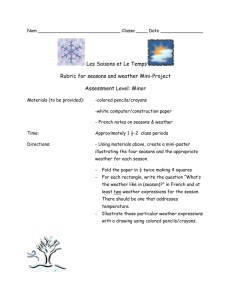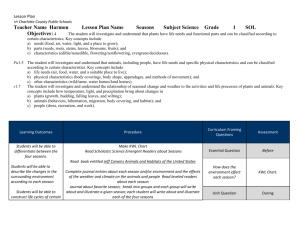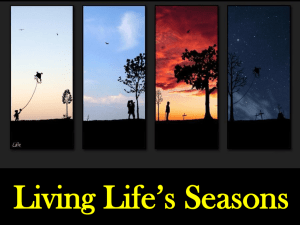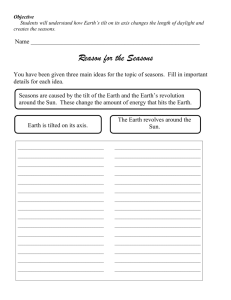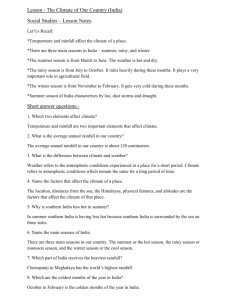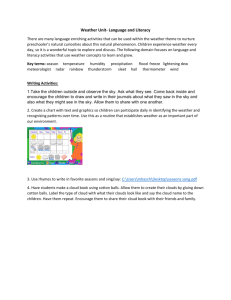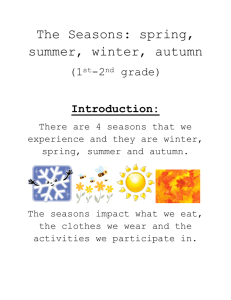KCMSPlanningDocument2012 Earth Systems, Structures and
advertisement
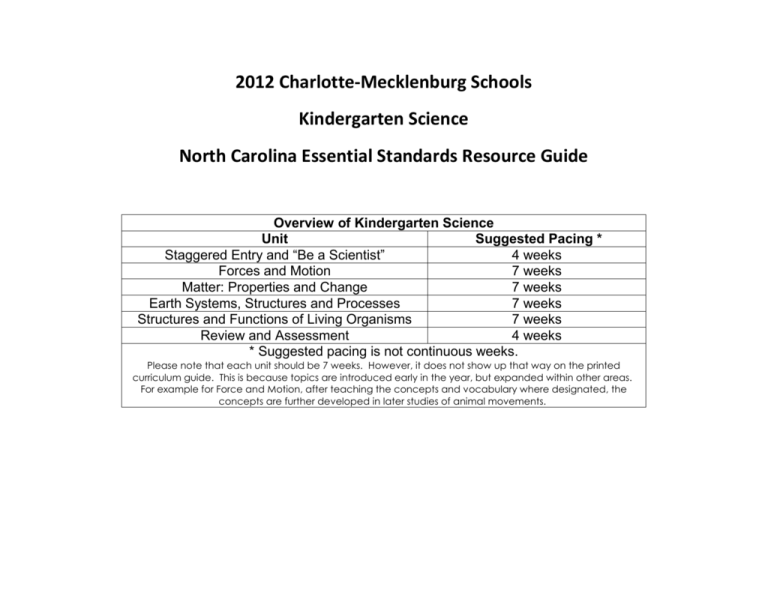
2012 Charlotte-Mecklenburg Schools Kindergarten Science North Carolina Essential Standards Resource Guide Overview of Kindergarten Science Unit Suggested Pacing * Staggered Entry and “Be a Scientist” 4 weeks Forces and Motion 7 weeks Matter: Properties and Change 7 weeks Earth Systems, Structures and Processes 7 weeks Structures and Functions of Living Organisms 7 weeks Review and Assessment 4 weeks * Suggested pacing is not continuous weeks. Please note that each unit should be 7 weeks. However, it does not show up that way on the printed curriculum guide. This is because topics are introduced early in the year, but expanded within other areas. For example for Force and Motion, after teaching the concepts and vocabulary where designated, the concepts are further developed in later studies of animal movements. 2012 Charlotte-Mecklenburg Schools – Kindergarten Science Earth Systems, Structures and Processes Essential Standard: K.E.1 Understand change and observable patterns of weather that occur from day to day and throughout the year. Clarifying Objective: K.E.1.1 Infer that change is something that happens to many things in the environment based on observations made using one or more of their senses. I can observe changes by using the 5 senses. K.E.1.2 Summarize daily weather conditions noting changes that occur from day to day throughout the year. I can show daily weather conditions. K.E.1.3 Compare weather patterns that occur form season to season. I can compare weather patterns from season to season. Unpacking: What does this standard mean that a student will know and be able to do? K. E.1.1 Student knows how to use observation skill to note characteristics of their environment on a daily basis. Students know that the weather may be sunny one day and cloudy another day. Students know how to compare their observations and describe how each observation is similar to or different form a previous observation K.E.1.2 Students know that weather changes from day to day. Students know how to maintain a daily weather journal and describe how the weather changes daily. K.E.1.3 Students build on the concept that change is something that happens t many things in the environment to include weather. Change can happen quickly or slowly. By observing daily weather changes, students can infer patterns that occur form season to season. Some weather patterns include sunny days, rainy days, windy or cloudy days, snowy days and stormy days. Students compare the weather patterns associated with each season: winter, spring, summer and fall (autumn). Students know seasons occur in a particular order and therefore the weather patterns associated with seasons occurs in a particular order. Essential Vocabulary: (K) Weather, Precipitation, Temperature, Rain, Snow, Hail, Fog, Wind, Hot, Cold, Seasons, Spring, Summer, Fall/Autumn, and Winter. 2 2012 Charlotte-Mecklenburg Schools – Kindergarten Science Essential Questions K. E.1.1. What can observations tell you about the environment? K. E.1.1 What weather changes do you observe? Criteria for Success: “I Will…” -Observe my environment each day. Ex: Go outside at the same time each day and notice temperature and weather. -Record characteristics of my environment each day: Hot/Cold, Sunny, Cloudy, Rainy, Foggy. Ex: Keep a journal of the weather conditions each day with pictures and /or words. -Explain how the weather changes every day using my notes/pictures. Ex: Use journal to tell others how the weather changes and can be different each day. K. E.1.1 What patterns in weather changes -Use my words to describe ways that the weather was similar or different over a period of time. Ex: Use journal to describe ways do you observe? that the weather was the same and ways it was different over time. K. E.1.2 Why does weather change from day to day? -Explain how weather can be different every day. Ex: Describe different types of weather they have observed. K. E.1.2 How can you record daily changes in weather? -Record the temperature and weather everyday in my weather journal to describe how weather changes daily. Ex: Keep a journal of weather conditions using pictures and words: Hot/Cold, Sunny, Cloudy, Rainy, Foggy K. E.1.3 Why does weather change quickly or slowly at times? -Describe how weather changes happen quickly or slowly. Ex; Sunny day->sudden afternoon storm Cloudy/Rainy day>suddenly clears quickly, Tornadoes! (very quick!) K. E.1.3 How can you decide that weather is different from season to season? -Know the four seasons. Ex: Use pictures and words to describe each season. -Explain what type of weather patterns happen in each season. Ex. Use pictures and words to show the weather patterns that happen in each season. K. E.1.3 What is the connection between weather patterns and each season? -Explain how each season’s weather is different or similar. Ex: Use my words to describe to others how the weather patterns are similar or different across seasons. K. E.1.3 Explain why seasons as well as weather patterns occur in order? -Demonstrate the order of the seasons. Ex: Explain the order/cycle of seasons. -Describe the order of the weather patterns and how they connect to the seasons. Ex: Use my words to describe how weather patterns and seasons are connected. Suggested Resources/Activities Unit D: Weather and Sky Lesson # 1. Exploring Weather pp.D2-D Read; The jacket I Wear in The Snow Lesson # 2. Look at Clouds pp.D10-D15 Read; It Looked Like Spilled Milk by Charles G Shaw; Clouds by Gail Gibbons; or The Cloud Book by Tomie DePaola Books: “I Like the Rain” a sing along book; Water by Canizares & Chanko; Rain by Kalan; Shine Sun! by Greene; What Will the Weather Be Like Today? By Rogers; I am Water by Marzollo. Lesson # 4. Sun and shadows pp D22-D27 Read: Bear Shadow by Asch; Shadows by Zimmerman; and Nothing Sticks Like a Shadow. Lesson # 3. The Seasons pp. D16- D21 When Spring (Autumn, Winter, Summer) Comes by Bruce Macmillan; It’s Spring! (Fall, Winter, Summer) by Berger. Read: Sadie and The Snowman Helpful Websites: http://scholasticlfo.com- with magazine subscriptions. Formative Assessment: Guide to Keeley’s Formative Probes- Dress Me Up! This probe elicits ideas about how weather impacts daily life. Why is it important to observe the weather? Why do we make weather predictions? 3 2012 Charlotte-Mecklenburg Schools – Kindergarten Science 4


